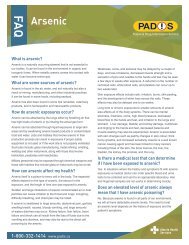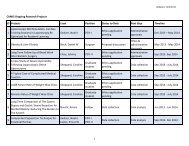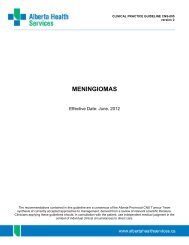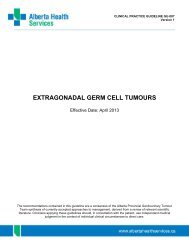taxanes in metastatic breast cancer - Alberta Health Services
taxanes in metastatic breast cancer - Alberta Health Services
taxanes in metastatic breast cancer - Alberta Health Services
You also want an ePaper? Increase the reach of your titles
YUMPU automatically turns print PDFs into web optimized ePapers that Google loves.
CLINICAL PRACTICE GUIDELINE BR-001<br />
paclitaxel 90 mg/m 2<br />
were significantly better <strong>in</strong> the weekly group [29, abstract]. Verrill et al.<br />
tected with respect to<br />
trend for longer median time to progression <strong>in</strong> the weekly group (6 versus<br />
versus 27%). Toxicity<br />
30 compared<br />
weekly x12 and paclitaxel 175 mg/m 2 q3 weeks x6. [30, abstract] No difference was de<br />
overall survival. There was a<br />
5.5 months) and response rate was significantly higher <strong>in</strong> the weekly group (43<br />
profiles of the two arms were similar.<br />
Data from the neoadjuvant and adjuvant sett<strong>in</strong>gs also suggests that weekly paclitaxel<br />
may be more<br />
effective than the q3 weekly regimen. In the neoadjuvant sett<strong>in</strong>g, Green et al. exam<strong>in</strong>ed<br />
weekly versus<br />
q3weekly paclitaxel regimens. response) were not<br />
ificantly better (28.2<br />
s worse with the<br />
east <strong>cancer</strong>, ECOG<br />
and docetaxel) follow<strong>in</strong>g a<br />
free survival differences emerged <strong>in</strong><br />
population. In an exploratory analysis of patients with ER negative disease, both the<br />
and q3weekly docetaxel arms proved superior to q3weekly paclitaxel <strong>in</strong> terms of disease<br />
en was superior to q3<br />
nstrated a<br />
ly paclitaxel compared with docetaxel every 3 weeks.<br />
31 Results for the primary outcome (cl<strong>in</strong>ical complete<br />
statistically different. For the weekly regimen, pathologic complete response was sign<br />
vs. 15.7%), as was the <strong>breast</strong> conservation rate (47 vs. 38%). Aga<strong>in</strong> neurotoxicity wa<br />
weekly regimen. In women with resected high risk node negative or node positive br<br />
1199 explored various taxane schedules (weekly versus q3weekly paclitaxel<br />
backbone of adriamyc<strong>in</strong> and cyclophosphamide. [32, abstract] No disease<br />
the overall study<br />
weekly paclitaxel<br />
free survival (81.5%/81.2% vs. 76.9% respectively). The weekly paclitaxel regim<br />
weekly paclitaxel <strong>in</strong> terms of overall survival (89.7% vs. 86.5%). This study also demo<br />
favourable safety profile for week<br />
Summary statement<br />
The CCO and NICE recommendations for use of s<strong>in</strong>gle agent <strong>taxanes</strong> were adapted. More current<br />
evidence <strong>in</strong> support of recommend<strong>in</strong>g docetaxel over paclitaxel q3 weeks, and further evidence <strong>in</strong> support<br />
of weekly taxane regimens was available.<br />
Recommendation #4<br />
Recommendations from exist<strong>in</strong>g guidel<strong>in</strong>es<br />
The CCO guidel<strong>in</strong>e<br />
<strong>in</strong>cludes docetaxel + capecitab<strong>in</strong>e as an option <strong>in</strong> younger patients with good<br />
performance status [6]. Assessment of the other regimens by the CCO guidel<strong>in</strong>e exam<strong>in</strong>ed,<br />
and all<br />
taxane/non-anthracycl<strong>in</strong>e regimens by NICE, was not possible due to lack of data at the time.<br />
the role of gemcitab<strong>in</strong>e <strong>in</strong> the<br />
management of <strong>metastatic</strong> <strong>breast</strong> <strong>cancer</strong>. 33 The CCO has, however, updated a recent guidel<strong>in</strong>e specifically on<br />
In this guidel<strong>in</strong>e they conclude that docetaxel + gemcitab<strong>in</strong>e<br />
can be considered as an alternative to docetaxel + capecitab<strong>in</strong>e based on a trial that the current panel has<br />
also exam<strong>in</strong>ed. This guidel<strong>in</strong>e also concludes that paclitaxel + gemcitab<strong>in</strong>e is an option but the cl<strong>in</strong>ical<br />
relevance questionable given that docetaxel has been the preferred taxane for use <strong>in</strong> <strong>metastatic</strong> <strong>breast</strong><br />
<strong>cancer</strong> <strong>in</strong> Ontario.<br />
It was noted that the BCCA, 9 NCCN 10 and CECOG 11 statements also <strong>in</strong>clude taxane/non-anthracycl<strong>in</strong>e<br />
regimens as options. BCCA considers docetaxel + capecitab<strong>in</strong>e or paclitaxel + gemcitab<strong>in</strong>e <strong>in</strong> the sett<strong>in</strong>g<br />
of an aggressive relapse <strong>in</strong> a fit patient. The NCCN considers the same two options. CECOG states that<br />
a taxane <strong>in</strong> comb<strong>in</strong>ation with either capecitab<strong>in</strong>e or gemcitab<strong>in</strong>e can be considered.
















